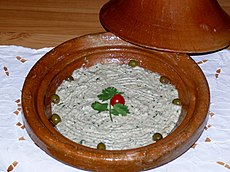Baba ghanoush
 | |
| Course | Appetizer |
|---|---|
| Place of origin | Levant[1] |
| Associated cuisine | Iraq, Armenia,[2] Syria, Jordan, Israel, Palestine, Lebanon, Egypt, Libya, and Turkey |
| Main ingredients | Eggplant, olive oil |
 Moutabbal (or M'tabbal) and pita bread | |
| Course | Appetizer |
|---|---|
| Place of origin | Levant |
| Main ingredients | Eggplant, olive oil |
Baba ghanoush (UK: /ˌbɑːbə ɡæˈnuːʃ/, US: /- ɡəˈnuːʃ, - ɡəˈnuːʒ/;[3][4][5] Template:Lang-ar ), also spelled baba ganoush or baba ghanouj,[3][4][5][6] is a Levantine appetizer consisting of finely chopped roasted eggplant, olive oil, lemon juice, various seasonings, and tahini.[5][6][7] The eggplant is traditionally baked or broiled over an open flame before peeling, so that the pulp is soft and has a smoky taste.[8] It is a typical meze ('starter') of the regional cuisine, often served as a side to a main meal and as a dip for pita bread.[6]
A very similar dish is mutabbal (Template:Lang-ar lit. 'spiced'). Mutabbal is sometimes said to be a spicier version of baba ghanoush. Mutabbal consists of mashed roasted eggplants, tahini, salt, garlic, lemon and often yogurt.[9][self-published source?]
Etymology
The bābā is an Arabic word that means 'father' and is also a term of endearment, while ġannūj could be a personal name.[4] The word combination is also interpreted as "father of coquetry" or "indulged/pampered/flirtatious daddy" or "spoiled old daddy".[3][6][10] It is not certain whether the word bābā refers to the eggplant, or to an actual person indulged by the dish.[6]
Varieties
Eastern Arabian cuisine versions of the dish vary slightly from those of the Levant by spicing it with coriander and cumin;[10] those versions might be minimally spiced and topped with thinly chopped parsley or coriander leaves.[11]
In Turkey, the dish is known as babaganuş or abugannuş. While the ingredients vary from region to region, the essentials (eggplants, tahini, garlic, lemon) are generally the same.[citation needed]
In Armenia, the dish is known as mutabal. The essential ingredients in Armenian mutabal are eggplant, tahini, garlic, lemon, and onion; and most Armenians also add cumin.[citation needed]
In Romania, a similar dish is known as salată de vinete. It lacks tahini and is made from finely chopped roasted eggplant, finely chopped onions, sunflower oil (explicitly not olive oil [12][13] because it makes the appetizer bitter), salt and, optionally, mayonnaise.[14]
In Syria, the dish is often mixed with sheep cheese, which turns it into a creamier dish.[15]
Food writer and historian Gil Marks writes in his book that: "Israelis learned to make baba ghanouj from the Arabs".[6] An Israeli variant, salat ḥatzilim, is made with fried or grilled eggplants mixed with mayonnaise, salt, lemon and chopped fried onions.[16][17] It is usually topped with olive oil when served.
See also
- List of dips
- Eggplant salads and appetizers, an overview of similar dishes prepared around the world
- List of Arab salads
- List of eggplant dishes
- List of hors d'oeuvre
- List of Middle Eastern dishes
References
- ^ "Baba Ghanoush". 13 September 2022. Retrieved 5 April 2022.
- ^ "Baba Ghanoush". 4 November 2011. Retrieved 19 May 2020.
- ^ a b c "baba ghanouj". The American Heritage Dictionary of the English Language (5th ed.). HarperCollins. Retrieved 25 April 2019.
- ^ a b c "baba ghanouj" (US) and "baba ganoush". Lexico UK English Dictionary. Oxford University Press. Archived from the original on 22 March 2020.
- ^ a b c "baba ghanoush". Merriam-Webster.com Dictionary. Merriam-Webster. Retrieved 25 April 2019.
- ^ a b c d e f Gil Marks (2010). "Baba Ghanouj". Encyclopedia of Jewish Food. Houghton Mifflin Harcourt. ISBN 9780544186316.
- ^ Baba ganoush (3rd ed.). Oxford University Press. September 2006.
A Middle Eastern (originally Lebanese) dish of puréed roasted aubergine, garlic, and tahini.
{{cite book}}:|work=ignored (help) - ^ Khayat, Marie Karam; Keatinge, Margaret Clark. Food from the Arab World, Khayats, Beirut, Lebanon.
- ^ "Middle Eastern Mutabbal Recipe". 29 March 2022.
- ^ a b Salloum, Habeeb (28 February 2012). The Arabian Nights Cookbook: From Lamb Kebabs to Baba Ghanouj, Delicious Homestyle Arabian Cooking. Tuttle Publishing. ISBN 9781462905249.
- ^ "Baba Ganoush: Quintessentially Levantine". Your Middle East. 7 January 2013. Archived from the original on 29 July 2019. Retrieved 29 July 2019.
- ^ Marin, Sanda (1995). Carte de bucate (Cookbook) (in Romanian). București (Bucharest): Editura Orizonturi. pp. 31–32. ISBN 973-95583-2-1.
- ^ Jurcovan, Silvia (2012). Carte de bucate (Cookbook) (in Romanian). București (Bucharest): Editura Humanitas. pp. 90–91. ISBN 978-973-50-3475-7.
- ^ Hansen, Eliza (1973). Meine rumänischen Spezialitäten (My Romanian Specialties) (in German). Hamburg: Ed. Christians. p. 10. ISBN 3-7672-0229-8.
- ^ "Baba ganoush ou caviar d'aubergines". Panier de Saison: recettes, accords mets-vins, jardinage et tourisme local (in French). October 2020. Retrieved 28 February 2023.
- ^ Levy, F. Feast from the Mideast (2003) p.41
- ^ Nathan, J. (2011). Joan Nathan's Jewish Holiday Cookbook. Knopf Doubleday Publishing Group. pp. 57–58. ISBN 978-0-307-77785-0. Retrieved 23 December 2016.
Bibliography
- David, Elizabeth (1950). A Book of Mediterranean Food. Alfred A. Knopf. ISBN 0-394-49153-X.
- Levy, F. (2003). Feast from the Mideast. Harper Collins. ISBN 0-06-009361-7.
- Trépanier, Nicolas (30 November 2014). Foodways and Daily Life in Medieval Anatolia: A New Social History. University of Texas Press. ISBN 978-0-292-75929-9.
- Appetizers
- Arab cuisine
- Assyrian cuisine
- Dips (food)
- Eggplant dishes
- Egyptian cuisine
- Iraqi cuisine
- Israeli cuisine
- Jordanian cuisine
- Lebanese cuisine
- Levantine cuisine
- Middle Eastern cuisine
- Palestinian cuisine
- Qatari cuisine
- Syrian cuisine
- Vegan cuisine
- Vegetable dishes
- Jewish cuisine
- Russian cuisine
- Balkan cuisine
- Central Asian cuisine

